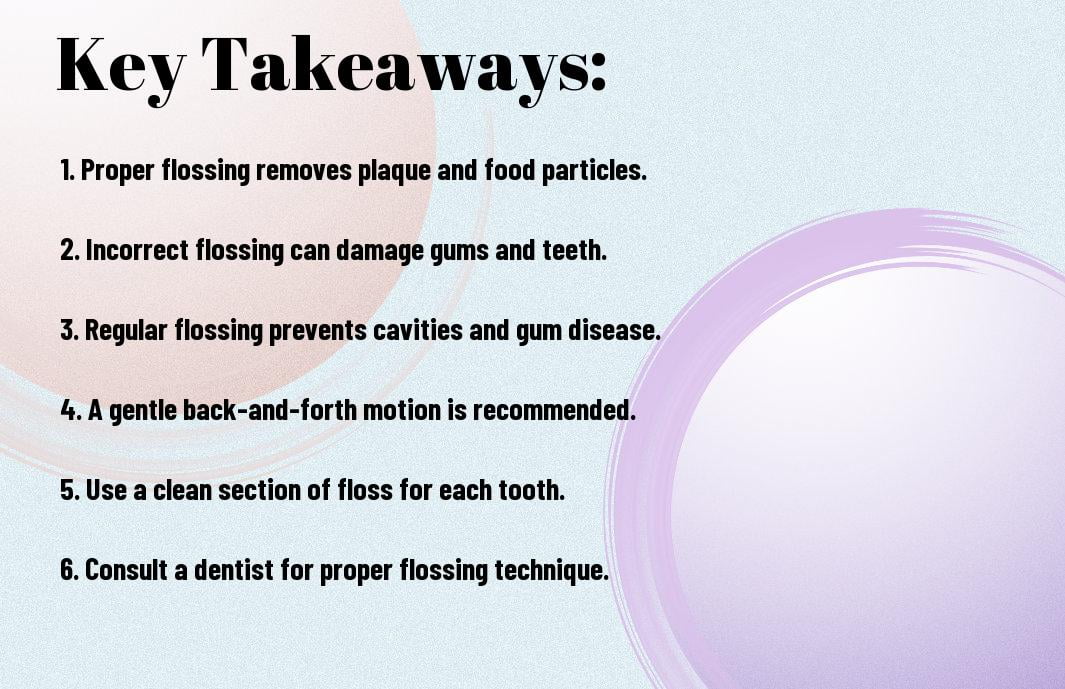Ensuring that you are using the correct flossing technique is crucial for maintaining a healthy smile. Proper flossing not only removes plaque and food particles, but it also prevents gum disease, cavities, and bad breath. Many people underestimate the impact of flossing, but the truth is that it can significantly improve your overall oral health. By using the right flossing technique, you can effectively remove debris from between your teeth and along the gumline, ultimately reducing your risk of developing serious dental issues. It’s time to prioritize your flossing routine and make sure you are doing it properly to reap all of the benefits it has to offer.
Key Takeaways:
- Proper flossing technique is essential for maintaining optimal oral hygiene and preventing dental issues such as gum disease and cavities.
- Using the correct flossing method ensures that all plaque and food particles are effectively removed from between teeth and along the gumline.
- Regular, consistent flossing with the right technique can help prevent bad breath and promote overall oral health.
- Improper flossing can lead to irritation and damage to gums, causing bleeding and inflammation.
- Consult with a dental professional to learn the correct flossing technique and ensure optimal oral care.
Understanding Proper Flossing Technique
One of the key components of proper oral hygiene is flossing. While it may seem like a simple task, flossing improperly can lead to damaging your teeth and gums. Understanding the correct technique is crucial to maintaining a healthy mouth.
Types of Dental Floss
When it comes to flossing, there are a few different types of dental floss to choose from. The most common types include waxed floss, unwaxed floss, and dental tape. Each type of floss has its own benefits, and it’s important to find the one that works best for you. Wax floss is ideal for those with tightly spaced teeth, while unwaxed floss may be more suitable for those with normal spacing. Dental tape is wider and flatter, making it the perfect choice for individuals with bridgework or wider gaps between their teeth. Assume that your dentist can recommend the best type of floss for your specific dental needs.
| Type of Floss | Best For |
| Waxed Floss | Tightly spaced teeth |
| Unwaxed Floss | Normal spacing |
| Dental Tape | Bridgework or wider gaps |
Step-by-Step Guide to Effective Flossing
Proper flossing technique involves more than just sticking a piece of floss between your teeth. To maximize its effectiveness, there are specific steps you should follow:
- Begin by breaking off about 18 inches of floss and wind most of it around one of your middle fingers, leaving an inch or two of floss to work with.
- Hold the floss tightly between your thumbs and forefingers and gently guide it between your teeth.
- Curve the floss into a C-shape against one tooth and carefully slide it beneath the gumline.
- Move the floss up and down against the tooth to remove plaque and debris.
- Repeat this process for each tooth, using a clean section of floss as you go.
| Step | Description |
| 1 | Break off floss and wind around finger |
| 2 | Hold floss between thumbs and forefingers |
| 3 | Curve floss into a C-shape against tooth |
| 4 | Move floss up and down against tooth |
| 5 | Repeat process for each tooth |
Benefits of Regular and Proper Flossing
Keep your dental health in check by incorporating regular and proper flossing into your daily oral hygiene routine. The importance of flossing extends beyond just preventing bad breath and keeping your teeth clean. By flossing regularly and correctly, you can reap a myriad of benefits that contribute to your overall oral health.
Prevention of Gum Disease
When you don’t floss regularly, you allow plaque to build up between your teeth and along the gumline. This can lead to the development of gingivitis, the mildest form of gum disease. However, if left untreated, gingivitis can progress to periodontitis, a more severe form of gum disease that can result in tooth and bone loss. By flossing daily, you remove plaque and food particles, preventing the onset of gum disease and maintaining the health of your gums. This simple practice can save you from the pain, discomfort, and cost associated with gum disease treatment.
Reduction of Tooth Decay and Plaque Build-Up
Proper flossing not only helps prevent gum disease but also reduces the risk of tooth decay and plaque build-up. When you neglect to floss, plaque accumulates between your teeth, providing an ideal environment for bacteria to thrive. Over time, this can lead to the development of cavities and tooth decay. By incorporating flossing into your daily routine, you effectively remove plaque from hard-to-reach areas, ensuring that your teeth and gums stay healthy and free from decay. Additionally, by reducing plaque build-up, you can also lower your risk of developing tartar, which can only be removed by a dental professional through professional cleaning procedures.
Addressing Challenges and Solutions
Unlike brushing, flossing can present some challenges that may make you want to skip it altogether. However, with the right techniques and tools, you can overcome these challenges and ensure that you are flossing effectively to maintain optimal oral health.
Handling Flossing with Braces or Dental Work
If you have braces or other dental work, flossing can be more challenging, but it is still essential for maintaining good oral hygiene. Using a floss threader or a water flosser can help you navigate around the wires and brackets to effectively remove food particles and plaque. Take your time and be gentle to avoid damaging your dental work.
Tips for Sensitive Gums and Teeth
If you have sensitive gums and teeth, flossing may cause discomfort or pain. However, it is crucial not to skip this step in your oral care routine. You can try using gentle or waxed floss to minimize irritation. Additionally, rinsing your mouth with an antibacterial mouthwash before and after flossing can help reduce gum sensitivity and prevent inflammation. Another helpful tip is to floss before brushing to remove debris and then follow up with a gentle brush to further clean and soothe your teeth and gums.
- Use gentle or waxed floss
- Rinse with an antibacterial mouthwash
- Floss before brushing
Though it may seem challenging to floss with braces or sensitive gums, finding the right tools and techniques can help you overcome these obstacles and maintain a healthy oral care routine. By taking these challenges head-on, you can ensure that your flossing technique is effective and beneficial for your overall dental health.
Incorporating Flossing into Daily Routine
After learning about the importance of proper flossing technique, you may be wondering how to make flossing a regular part of your daily routine. One helpful tip is to read more about the importance of proper flossing in Queens, NY.
Creating a Flossing Habit
One of the best ways to incorporate flossing into your daily routine is to make it a habit. Set a specific time each day for flossing, such as after brushing your teeth before bed. By making flossing a regular part of your routine, you are more likely to remember to do it. You may also want to keep floss in a visible place to serve as a visual reminder to floss every day.
The Role of Flossing in Overall Dental Care
When it comes to your overall dental care, proper flossing plays a vital role. Not only does flossing remove food particles and plaque from between your teeth, but it also helps prevent gum disease and tooth decay. Failure to floss can lead to gum inflammation, cavities, and even tooth loss. By incorporating flossing into your daily routine, you are taking an essential step in maintaining the health of your teeth and gums.
FAQ
Q: Why is proper flossing technique important?
A: Proper flossing technique is important because it helps to remove plaque and food particles from between teeth and along the gumline, which can prevent tooth decay, gum disease, and bad breath. Flossing also helps to stimulate the gums and reduce inflammation, contributing to overall oral health.
Q: What is the correct way to floss?
A: The correct way to floss is to use a piece of floss about 18 inches long, winding the ends around your fingers and gently guiding the floss between each tooth in a C shape, hugging one tooth and moving it up and down against the side of each tooth. It is important to use a clean section of floss for each tooth and to be gentle to avoid causing damage to the gums.
Q: How often should I floss?
A: It is recommended to floss at least once a day, ideally before brushing your teeth. Flossing every day helps to maintain healthy gums and teeth by removing plaque and preventing the buildup of tartar. However, if you have certain dental conditions or braces, your dentist may recommend flossing more frequently to maintain oral health.







